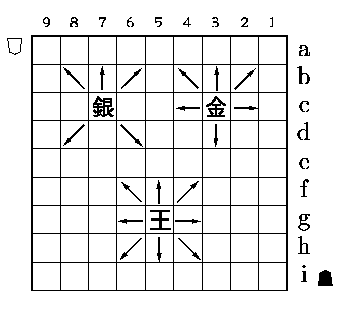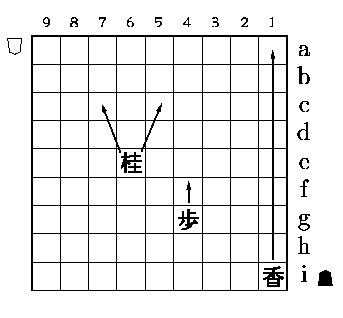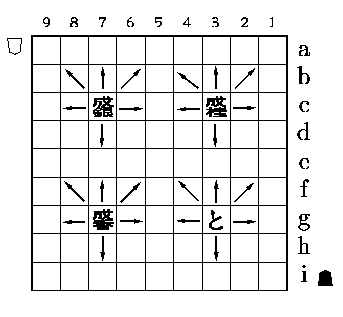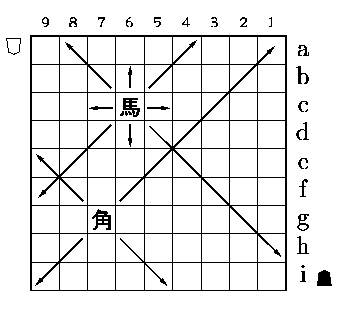|
|
Shogi
Rules
- The board has size 9 * 9
- Shogi is a game for two players (black and white).
Black plays `up' the board, white `down'. Black plays first.
- The object of the game is as in western chess to checkmate the opposing king
- The pieces
 King King
Each player has 1 king.
The king occupies the centre of the first rank, ie: black's king is on i5,
and white's is on a5.
The king may move 1 square in any direction like the king in chess (see Diagram 1).
The king does not promote.
 The gold The gold
Each player has 2 golds.
The golds occupiy the 2 positions either side of the king,
ie: black's golds are on i4 and i6, and white's are on a4 and a6.
The gold moves one square in any direction except the two rearward diagonal squares,
(see Diagram 1). The gold does not promote.
 The silver The silver
Each player has 2 silvers.
The silvers occupy the 2 positions either side of the golds,
ie: black's silvers are on i3 and i7, and white's are on a3 and a7.
The silver moves one square in any direction except orthogonally left, right or backwards,
(see Diagram 1).
The silver may promote to gold once it has entered the promotion zone and
the promoted silver looks like this: 

Diagram 1
 Knight Knight
Each player has 2 knights.
The knights occupy the 2 positions either side of the silverss,
ie: black's knights are on i2 and i8, and white's are on a2 and a8 (see Diagram 2).
The knight moves one square forward and then one square diagonally,
left or right (ie: a restricted form of the knights move in Chess),
Pieces on the intervening squares are ignored.
The knight is the only piece which may jump other pieces in this way.
The knight may promote to gold once it has entered the promotion zone
and the promoted knight looks like this:  (see Diagram 3)
(see Diagram 3)
 The Lance The Lance
Each player has 2 lances to start with.
They occupy the corners of the board, ie: black's lances are on i1 and i9,
and white's are on a1 and a9. The lance moves any number of squares forward,
that is, any number of squares (see Diagram 2).
When it enters the opponents promotion zone (the furthest away third of the board),
the lance may promote to gold if desired and the promoted lance looks like this:
 (see Diagram 3) (see Diagram 3)
 The Pawn The Pawn
The pawns occupy the third rank on each side.
Each player has 9 pawns to start with.
The pawn moves one square forward, that is, one square (see Diagram 2).
When it enters the opponents promotion zone, the pawn may promote to gold
if desired.
The promoted pawn looks like this:  (see Diagram 3)
(see Diagram 3)

Diagram 2 |

Diagram 3 |
 The rook The rook
Each player has one rook which occupies h2 (black) and b8 (white) at the start of the game.
The rooks move is the same as that in Chess - any number of squares in
any of the orthogonal directions.
The rook may promote and acquire the extra power to move one square
only in any of the orthogonal directions.
The promoted rook looks like this:


 The bishop The bishop
Each player has one bishop which occupies h8 (black) and b2 (white) at the start of the game.
The bishops move is the same as that in Chess - any number of squares in any of the diagonal
directions. The bishop may promote and acquire the extra
power to move one square only in any of the orthogonal directions.
The promoted bishop looks like this:


- Promotion
Most pieces (pawn, lance, knight, silver, rook, bishop) may be promoted on reaching the
promotion zone (the furthest away three ranks of the board).
Pieces are promoted by turning them over so that their promoted characters are visible.
Pawn, lance, knight and silver promote to gold.
Rook and bishop have their powers enhanced by being allowed to move one square
in a diagonal (rook) or orthogonal (bishop) direction.
Note that promotion is not mandatory, and there are some strategic situations
in which it may be disadvantageous to do so.
Note however, that when a piece would no longer have a valid move after the current one,
it must promote - that is, when a lance or pawn reaches the last rank,
or when a knight reaches either of the last two ranks.
Once promoted, a piece may not be `unpromoted'.
Finally, remember that although the discussion above assumes that promotion takes place (or not) when a piece first enters the promotion zone, in fact, a piece may be promoted in the course of a normal move as it enters or leaves the promotion zone or as part of a move entirely within the promotion zone.
Pieces may not `un-promote'.
- Drops
A player may drop a captured piece instead of moving a piece.
This is one of the features which makes shogi so different from chess.
Basically a piece may be dropped anywhere with the provisos that:
- It is forbidden to have more than one unpromoted pawn on the same file;
- A pawn may not be dropped to give direct checkmate;
- A piece may not be dropped where it does not have a legal
move (ie: a lance or pawn on the last rank, or a knight on either of the last two ranks);
A piece may not be promoted as it is dropped
(a dropped piece may only be promoted after it has actually moved).
Links
There are a lot information about Shogi on internet
Check these links:
If you are game developer you must read it: YSS 7.0
|